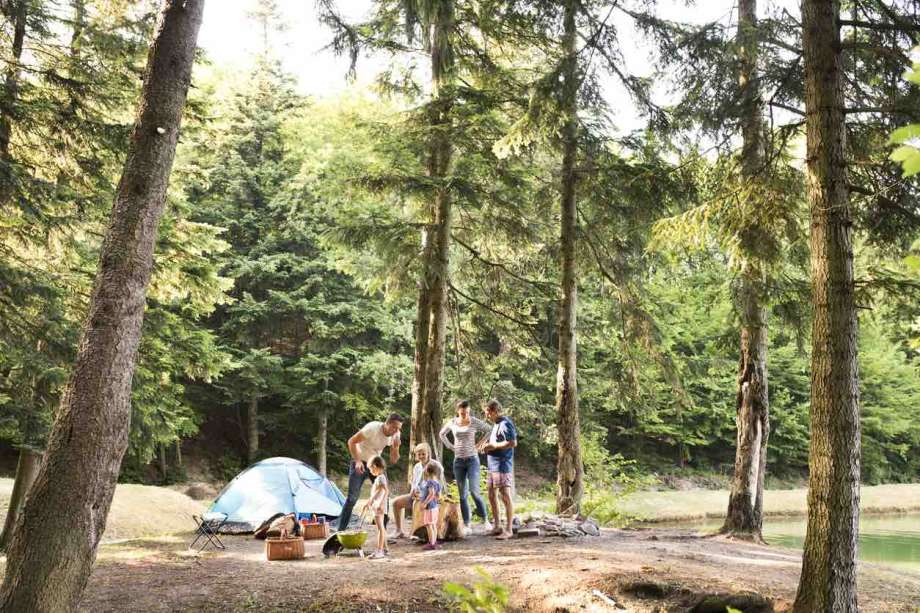Before your family goes hiking or camping this summer, read up on some common-sense safety tips.
Avoid injury and other hazards
Avoid Sunburn and Heat Ailments Eight hours or more in the sun is a wonderful way to spend the day, but it also comes with some hazards. Sunburn is the most common sun-related ailment from hiking, and also the easiest to prevent. Apply SPF 15 or higher sunscreen to all exposed areas before you begin your hike - give it at least half an hour to absorb into your skin. While many sunscreens claim to be waterproof and to last all day, it's still a good idea to re-apply every few hours, since you're likely to be sweating. You should also wear a hat, and, temperature permitting, long pants and sleeves.
Sunburn isn't the only thing to watch out for. Sunstroke, heat exhaustion, and other heat-related ailments can plague hikers. Staying hydrated, as detailed above, is the first step toward regulating your body temperature. It's also a good idea to take frequent, brief stops (which will also help you appreciate your surroundings!).
On the flipside, watch out for hypothermia. Temperatures can drop precipitously at night or in the shade. Even sweating, your body's natural cooling system, can cause you to cool off too much if you suddenly stop moving and there's a breeze. Dress in layers, adding or removing clothing as appropriate.
Respect Wildlife Encountering wildlife is one of the true pleasures of hiking. The woods are full of activity, including birds, snakes, and mammals large and small. Unlike house pets, though, these wild animals are best viewed from a distance, preferably through binoculars or a telephoto lens. While animal attacks are rare, they do happen, and are best prevented with some simple safety practices.
Most animals prefer to avoid humans altogether. If they hear or smell you coming, they will flee. Hikers in groups are often noisy (and odorous) enough to give the animals plenty of warning. Solitary hikers, or pairs of hikers, run the risk of surprising an animal, which can be dangerous. One easy tip is to attach a bell to your backpack. It'll jingle with every step.
At night, round up all the food in your party in a plastic bag, and hoist it up over a tree branch. This is called a "bear bag," although it's intended to protect you and your campsite from all sorts of hungry critters. A few tips for bear bag placement: Put it up further from your campsite than you may initially think is necessary - at least several hundred yards. Try to get it at least 20 feet above the ground, because bears can reach nearly that high when they stand on their back legs. And finally, keep it away from the trunk of the tree, because bears are adept climbers.
Research what kind of wildlife you may encounter in your neck of the woods. The more docile black bear, common in the northeast, rarely tangles with hikers, while the northwestern brown bear may be a bit more aggressive. Moose can be territorial, and are best avoided altogether. In all cases, stay away from the creatures' young. Remember that most animals will steer clear of you. You should extend them the same courtesy.
Other Safety Tips Avoiding injury is of paramount importance. Besides wearing good boots, using a walking stick can help. Walking sticks are helpful for a few reasons: They can help hikers maintain balance across uneven terrain, like rocks or streams; they reduce the stress on your shoulders and hips from carrying your pack; and they're great to rest on when you stop. You can buy wooden walking sticks, or light, sturdy ones made from synthetic materials. It's also possible to find one in the woods from a fallen branch, but don't saw or snap a branch from a live tree in order to make a walking stick.
Insects are more dangerous than bigger animals in some ways, because they seek out humans, and they're certainly more numerous. Apply bug spray early and often to fend off mosquitoes, horseflies, and other bloodsuckers. Periodically, you may want to check yourself and the kids for ticks. And steer clear of bees' nests, anthills, and other such hives.
Make sure that you and your kids can identify and avoid dangerous plants, such as poison ivy and poison oak. And although kids may be tempted by wild berries or mushrooms, it's best to refrain from eating them even if you think you know what they are. Not only are you robbing animals of a potential food source, but it's hard to be sure what you're putting into your body when you find it in the wild.
Nothing can seem more dangerous than ending up stranded or alone on a hike. Carry a whistle and make sure your kids do, too. And have a meet-up plan in the case of separation.
